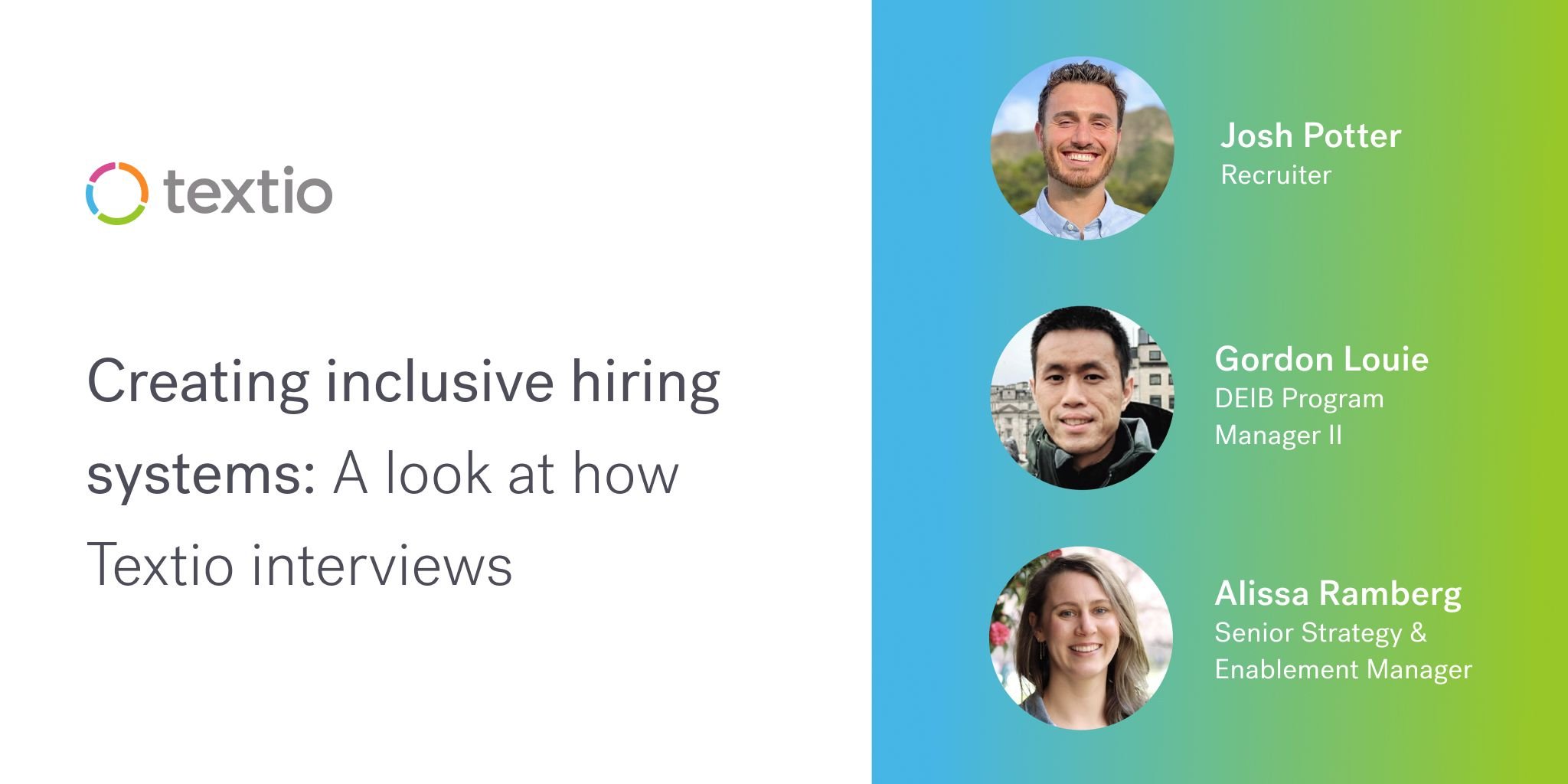3 inclusive hiring practices to improve your candidate experience

Do you remember your worst candidate experience ever? Of course you do! Those experiences are hard to forget. Perhaps you were asked the same generic questions by multiple interviewers in a row. Or maybe you were ghosted after a lengthy take-home assignment. Whatever the case, chances are it soured your impression of the company and its culture.
Impressions matter. They make a big difference in your company’s ability to attract and hire talent. When a company uses inclusive hiring practices, they are able to identify and hire the strongest candidate for the role. They also tend to have a stronger candidate experience overall, which helps their employer brand.
We’re often asked how we set up our hiring process at Textio. While there is no one formulaic way for all companies to recruit and interview, the principles that Textio uses can provide a great foundation for any team. Recently, Textio hosted a webinar to share our process and principles with our community. Below are a few highlights.
What is inclusive hiring?
Inclusive hiring means attracting a diverse talent pipeline, minimizing bias, and providing an excellent candidate experience. If your company is prioritizing attracting a more diverse team or just trying to create an objective process, inclusive hiring will help you get there.
Scaling inclusive hiring takes work and ongoing effort. It also encompasses many areas of the candidate journey. To keep it simple, we've boiled it down to three aspects: using inclusive language, sourcing strategically, and interviewing consistently.
1. Use inclusive language
Language is key to success in the “attract” component of hiring. You’re only going to be able to evaluate candidates who make it into your pipeline. And who applies for a role at your company is partially a result of how you communicate. That means that if you want to access the broadest pool of candidates from diverse backgrounds, you'll need to think intentionally about the language you and your entire team are using and how it lands with your audience.
This is why Textio—as a technology, and as a company—is so focused on the words and language aspect of the candidate experience. It’s so important (but can be difficult) to get this part right. For example, if you’re using commonplace language like “hustle” or “deadline-driven” in your job posts, you may not be aware that you are actively turning certain groups of talent away. There’s nothing “wrong” with these words per se, but they do impact your ability to resonate with all candidates. Using inclusive language across all of your recruiting communication channels helps you unlock access to talent.
2. Source strategically
You can't hire candidates who don't know that your company exists or that you have an open role. Sourcing is an important part of an inclusive hiring strategy. Sourcing inclusively and strategically ensures that you're building a robust enough talent pool early on. Where you post jobs can be a deciding factor in how much engagement you have with your open roles. And, taking ownership of how your company is perceived (your employer brand) sets you up for success in your sourcing efforts. This is especially true when you are trying to engage with passive candidates.
In order to expand your access to talent, stay proactive and engage in many different networks in a thoughtful way. Try taking a step beyond LinkedIn to engage other candidates in new networks, especially if you're not getting enough traction in your existing diversity recruiting efforts.
3. Interview consistently
We can't see our own unconscious biases. That's why everyone—no matter how knowledgeable or aware of bias in theory—requires systems and structure to stay objective. As an interviewer, you play a crucial role in your team’s talent acquisition process. How you evaluate candidates once they’re in your pipeline is the deciding factor on if you can go from a diverse talent pipeline to a diverse company.
If the process you’re using isn’t consistent, you risk hiring candidates who aren’t the best fit for the role, and you may also be reinforcing bias. Interviewing systems can vary, but successful and objective ones standardize for effectiveness, rely on behavior-based or skill assessments, and put a strong candidate experience first.
Remember, if the general concepts of your tools and training aren't followed across the entire hiring team’s practices, they won’t produce the results you’re looking for. Each and every interviewer makes a difference, as does the experience that they create for candidates.
This topic was covered in our Inclusive Hiring Systems webinar. You can access the recording here for many more insights.